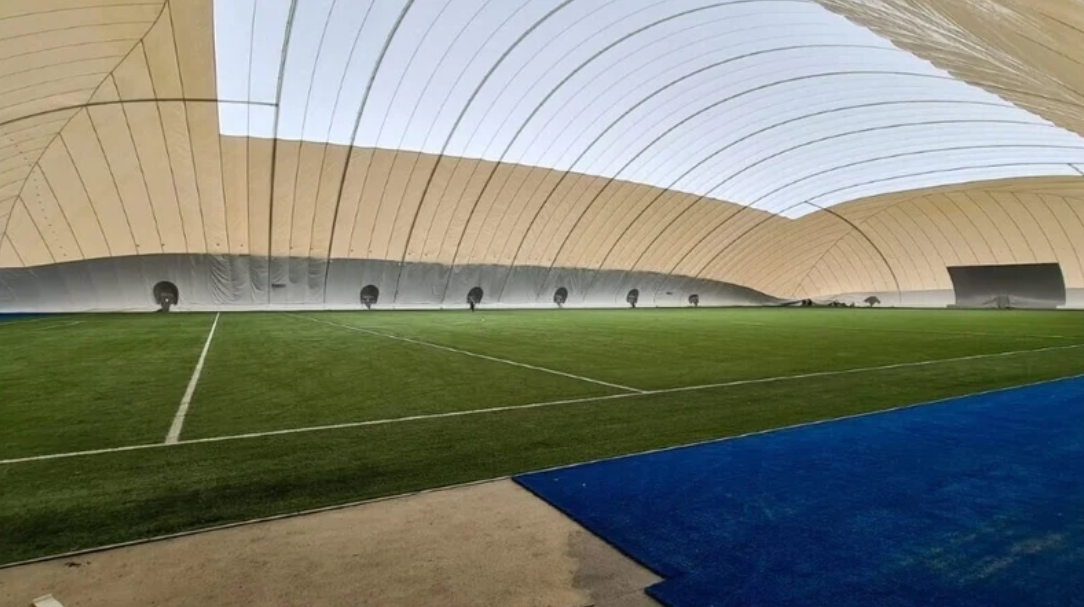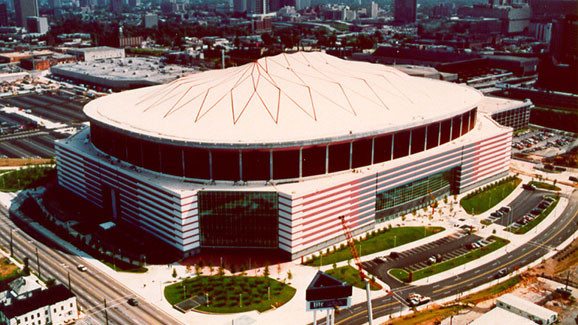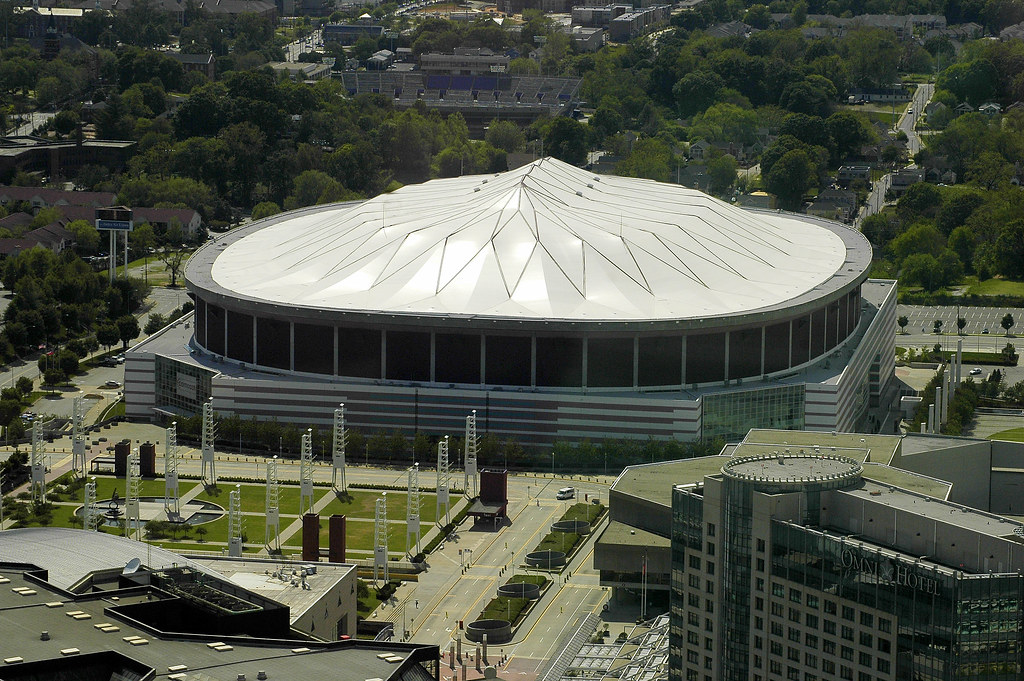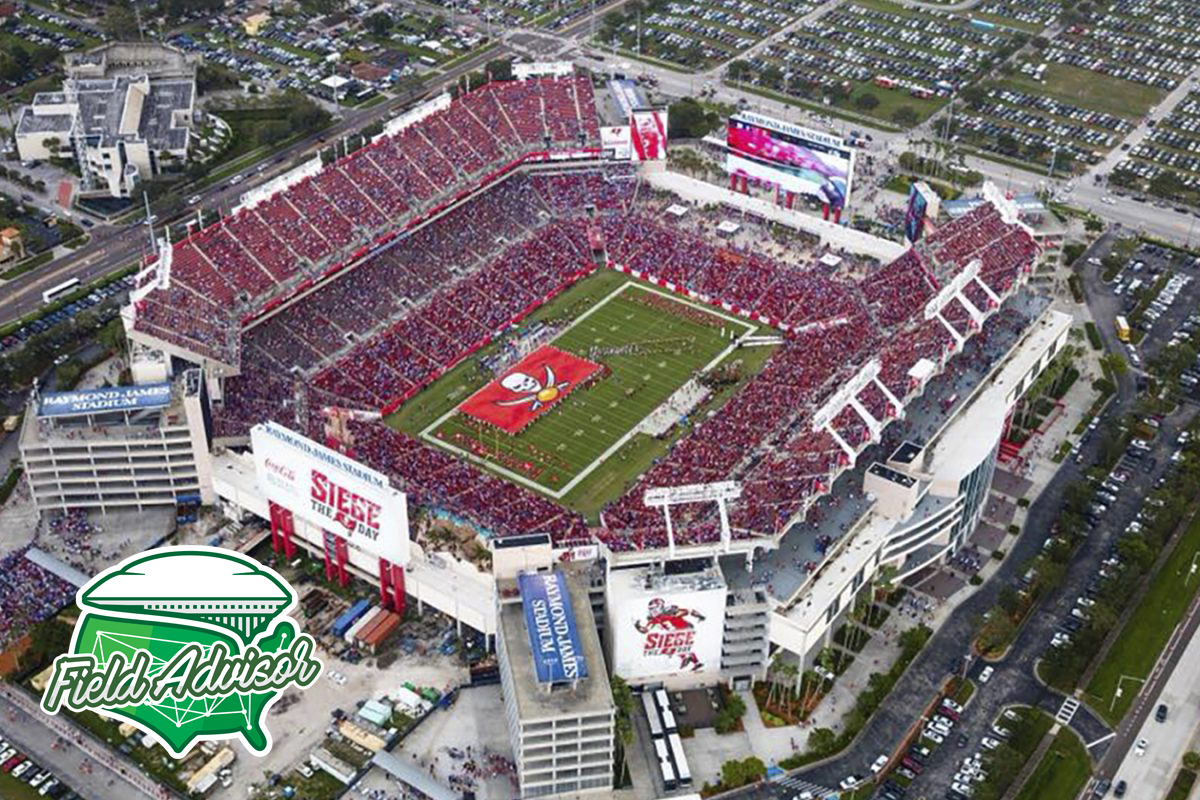On the afternoon of January 3, l962, seven armed men in cowboy hats met on the outskirts of Houston. The site was dismal, known for damp summers and mosquitoes the size of turkey buzzards. At the appointed hour, the men took their Colt .45s, fired them into the earth and thus broke ground for a stadium to house the city's new baseball franchise, a team then known as the Colt .45s and now called the Astros. The men were also breaking ground-or so many Houstonians were ready to argue-for a new millennium in American sports. The building they were about to put up was no mere ballpark but an indoor sports theater, a palace even, with upholstered seats, air-conditioning and a Louis XIV bedroom in a VIP suite, all under a steel dome spanning 642 feet. "This is going to be the sports showplace of the nation," said Judge Roy Hofheinz, president of the Houston Sports Association.
Which Stadiums Have Domes But Hofheinz spoke wisely when he said other cities would follow. Since the Astrodome opened in 1965, 15 enclosed stadiums have gone up under roofs of steel, wood or, most often, fabric. The newest dome, in St. Petersburg, Florida, is due for completion in 1989-a grand gesture of civic optimism, since there is no guarantee that a professional baseball or football team will start up there anytime soon. In contrast to college football stadiums, the largest of which can and regularly do accommodate over 100,000 spectators, no stadium in the league currently has a listed seating capacity of more than 82,500. In the opposite direction, the league has a firm minimum on the number of seats an NFL stadium should have; since 1971 the league has not allowed any stadium under 50,000 seats to host a full-time NFL team.
What really got the dome boom going was an outlandish entry in the architectural competition for the U.S. exhibition hall at Expo '70 in Osaka, Japan. Davis-Brody, a New York firm, designed a sort of pumpkin on top of an inverted pyramid, together 30 stories high. The pumpkin was to be built of fabric and held up by air, a type of structure that until then had been used to house only tennis courts and military radar installations. The architects scouted around for an engineer who could flesh out the design concept and they wound up with David Geiger, then a young adjunct professor at Columbia University.
The design won, but Geiger found himself stuck with a site that was prone to earthquakes and 150 mile-an-hour typhoons. In desperation, the design team took a vertical cross section of the pumpkin and laid it flat on the ground, preserving the blocky, superelliptical outline-and very little else-from the original plan. It consisted of an earthen berm topped by a concrete ring and enclosed two and a half acres under a vast fabric lid. But it set the pattern for most of the domed stadiums built since then. A system of fans held up the fabric roof by boosting air pressure inside. A web of cables thrown over the top secured the fabric and divided it into pillowy sections.
Figuring out the cable pattern was the hardest thing, even with the help of an advanced computer. Geiger found that a standard grid, with cables crossing at right angles, caused the roof to sag at the perimeter. But one Saturday, in a moment of inspiration, he realized he could eliminate the problem by running the cables diagonally. This "skewed symmetry" still characterizes almost all such roofs. The Saints are the only team to have won a Super Bowl at home, a domed stadium. Miami's Hard Rock Stadium hosted the championship game, and the Colts' home games were played in a retractable roof stadium.
A dome also requires turf, and there's a big debate between the effects of natural grass and artificial turf. There were no domed stadiums until 1962, a few NFL stadiums predate it, so requiring every team to use a dome is unrealistic. The Big Ten continues its attempts to string together plans for a potential winter football season, and a part of those plans could be playing inside domed stadiums. Conventional open stadiums gravitate to the outskirts of the city, where land is cheaper and there is ample room for parking.
With only 15 or 20 major events at a football stadium or 81 games at a baseball stadium, it's hard to justify paying downtown real estate prices. But with a lid, Geiger says, an ordinary stadium becomes "an entertainment machine" capable of accommodating 250 events a year and, when it is located at the center of the city, hotels and restaurants tend to spring up around it. In its first ten years, the Superdome's boosters claim, it had a $2.678 billion economic impact on the community. Out of 225 regular-season and playoff games in the four stadiums, 149 have been played with the roof closed and 76 with it open.
Pricing is also a factor when it comes to building domed stadiums. The added price of an extra roof often inflates the budget of a stadium. Any city or financier of a stadium would not want extra tens or hundreds of millions added to their stadium project because of an "unnecessary" component. There's plenty to debate within the NFL's various playing surfaces, and there are also plenty of complaints to go around. The trend is toward artificial turf, as several stadiums have replaced natural grass with artificial turf in recent years.
Facilities managers say artificial grass provides a more consistently reliable surface than natural grass fields. However a majority of NFL stadiums now use artificial turf, a big vote of confidence in commercial artificial grass. If it's good enough for millionaire athletes, chances are that it's also good enough for your home or business lawn.
NFL teams with retractable roofs say weather conditions and fan comfort are the driving factors in their open-or-closed choices. The decision can be easy on days of heavy rain or extreme temperature, but controversial in some other conditions, such as days when direct sun makes certain seats uncomfortable. And non-meteorological factors also are believed to influence the decision at times, such as a team's desire for louder crowd noise in a closed stadium or a coach's (or quarterback's) preference for controlled conditions. Million to a domed stadium project, and it typically costs a few thousand dollars to open and close the structures each time, said Mark Waggoner, a structural engineer who has had a hand in several pro sports stadiums.
Going into the 2016 season, 24 out of 32 teams will only be able to play their home games outdoor. The Cardinals, Colts, Cowboys, and Texans play in those stadiums. In the future, more franchises may opt to break ground on domed and retractable-roof venues, but the data indicates it isn't in their best interest, unless every team is on an equal playing field. Until then, the teams with open-field stadiums appear best suited to march on to victory, especially when the games count the most. Or rather, what they have on their drawing boards are buildingscalled domes.
In classical architecture, as with St. Paul's Cathedral in London, a dome wasn't a dome unless it had a roughly hemispherical shape. But that ceased to be true with the Astrodome's first imitator, the Idaho State University Minidome, a stadium in Pocatello shaped like a Quonset hut (students called it the "half-Astrodome"). The word "dome" has since come to describe any place big enough to accommodate baseball or football-but with a lid. In some of the latest schemes, the lids resemble circus tents, saddles, ridged potato chips. These domes have been labeled modern-day cathedrals, civic icons, the symbols by which cities declare their status as world-class players.
They have changed not just the architecture but also the economics of urban life. They have certainly reshaped American sports-notably at the last World Series, in which, some people asserted, the Minneapolis Metrodome should have been named the Most Valuable Player. When Pope John Paul II visited New Orleans last year, 55,564 people heard him speak at the Superdome . And when the Republicans nominate a Presidential candidate at the Superdome this summer, theirs will be the first, but surely not the last, dome convention. After a little more than a quarter-century, we are knee-deep in what one sports trade journal terms the "dome age." The one key element that can change from stadium to stadium is the playing surface.
There is no set rule for real grass versus turf, so it is up to each stadium to decide. The four NFL teams with retractable-roof stadiums have chosen to play almost twice as many games with the roofs closed than with them open. That lone statistic raises the question of whether the convertible tops, such as the one planned for a new Atlanta stadium to be partially funded with public dollars, are worth the increased cost over a fixed dome. We've had season tickets for the Texans at Reliant Stadium for the past few years and when the roof is closed the place feels great.
The atmosphere is insane inside domed stadiums, and maybe it's because i've actually never seen a professional event in an outdoor stadium, . They do a great job of regulating the temperature and it really does amplify the noise making the game that much more enjoyable. Strangely enough, those are the only times the Super Bowl has ventured north.
The NFL prefers holding the game in Southern warm-weather cities, and it's no coincidence that three of the four cities above have domed stadiums. The 2014 game at MetLife was the only time a Super Bowl was held outdoors in a cold environment. That they keep having to pull out seats says all you need to know.
(It's sort of like how New Comiskey missed the retro trend started by Camden Yards). Deflations, while bad, aren't usually all that bad because the roof will hang up over the spectator area even when bellied down. But when the Silverdome in Pontiac, Michigan, deflated under heavy snow in March 1985, the fabric tore on some lighting framework and high winds whipped it like a sheet on a clothesline.
A weather radar system now watches over the new roof, whlch cost $10 miIlion. At the Metrodome in Minneapolis, a 1986 incident led to a partial evacuation during a Twins game attended by 32,000 people. When wind shear hit one side of the roof, the control system registered it as a surge in the building's air pressure and, instead of tautening the roof against the wind, automatically began dumping air to compensate. The 10,000-pound light banks and the ceiling-hung speakers started to sway, and plugs in the roof popped, pouring water down the third-base line.
Spectators on the upper decks had to evacuate, using revolving doors to avoid further loss of pressure. But such incidents are one reason why engineers have developed new ways to put up domes. In 2010, the first bowl game was played in this stadium and became the third-highest attendant game of all Cotton Bowl games.
AT&T also holds a record for arranging 101,763 seats for fans in professional wrestling of 2016. Kirby Lee-USA TODAY SportsRANKING NFL STADIUMS TOP-FIVE Built for $1.9 billion, one would certainly hope Allegiant Stadium delivered a tremendous fan experience. Even before people walked in for NFL games, the place drew glowing reviews for concerts. Fans experienced major traffic problems getting to the stadium, located in Paradise, but it's worth it once you step inside.
With 65,000 seats, the Wynn Field Club and an array of restaurants (BBQ Mexicana, Guy Fieri's Tailgate Kitchen and Bar, Pizza Rock) and so much more, Allegiant Stadium needs to be on bucket lists. Santa Clara, California, USA; Pregame festivities before the San Francisco 49ers play against the Minnesota Vikings in the NFC Divisional Round playoff football game at Levi's Stadium. Kirby Lee-USA TODAY SportsIt's inexcusable that a stadium that opened just a few years ago is this mediocre. Of course, it doesn't help that they built it in Santa Clara to make the travel experience worse for fans. Did we mention that they spent over $1 billion on this place and failed to protect fans from the glaring sun? If you can look past the inconvenient location, the sun in your eyes and the costly tickets, everything else is really nice.
Thanks to the COVID-19 pandemic, many NFL stadiums prevented fans from attending games early in the regular season. As the year unfolded, with the NFL losing billions of dollars in stadium revenue, teams started welcoming a smaller number of fans back into their buildings. "The football games have probably the least to do with that decision," Waggoner said. If a municipality wants the stadium for use in concerts, rodeos or other year-round events, a closed building is the way to go. Purists who see football as an outdoor game may be mollified by the open-stadium option of a retractable roof. For the players, this could also be seen as the perfect place to play a game.
No wind that disrupts the passing while the quarterback attempts a game-winning touchdown. No worrying about the possibility of fumbling the balls due to rain making it wet. Players also no longer wonder when playing in certain cities, if they will have to deal with a blizzard.
A domed stadium allows for the perfect playing conditions for teams, putting everyone in a great place to play. Four teams have closed roofs, including the Detroit Lions, Las Vegas Raiders, New Orleans Saints, and Minnesota Vikings. Five have retractable roofs that can be opened or closed, including the Minnesota Vikings. NFL stadiums are an icon that have become a piece of the glorious culture and sport we call football.
As we look back into the pages of time, most of the oldest NFL playing turfs were not even stadiums at all. In fact, many of the oldest stadiums that are still used by NFL teams back in the original years were fields that would pale in comparison to some of the most elaborate home fields today. For the St. Petersburg stadium, Geiger has veered off in an entirely different direction. It will have a nonretractable fabric roof held up by cables rather than by air.
He says he was inspired this time by the economics of litigation. "Bucky fell in love with triangles," says Geiger, now 52, with wavy, disheveled gray hair and wearing tortoise-shell bifocals. "He made his fame with the geodesic dome, which was essentially triangulating the surface of the sphere." But Fuller also had another concept, the "tensegrity" dome, which never got off the drawing board.
His geodesic domes were built of rigid structural elements under compression; the tensegrity dome would depend largely on structural elements under tension. Geiger developed a modified tensegrity configuration for St. Petersburg's dome. All the cables pass through a single point at the center of the roof. These cables are supported at intervals by vertical posts, which in turn stand in midair on a system of four concentric cable hoops. Other cables, running diagonally, hold posts and hoops in place, under tension. The roof will weigh two to four pounds per square foot, versus one pound for an air-supported roof and 30 to 40 pounds for a steel roof, and it is designed to stand up to weather without special care.
On the other hand, even ordinary domed stadiums can blow $10,000 a day on heat when they wheel in steel grandstands from a cold warehouse. "It's like putting a big ice cube in your bathtub," says Bob Haney, the operations director at the Silverdome. Luckily, the University of Southern California Trojans played their home games there.
A LawnStarter review of turf at the NFL's 31 stadiums shows that 17 are equipped with artificial turf and 14 with natural grass. In all, 32 teams compete in the NFL; the New York Giants and New York Jets share a stadium. For some players, it doesn't matter whether they're competing on artificial turf or natural grass. Now, however, it seems like NFL teams have more money than they know what to do with. And, with many teams recently switching cities, a few more new builds are in the works. The new Inglewood stadium being built for the Rams and Chargers will have a retractable roof.
A Super Bowl was awarded to Kansas City, but only conditionally, and when they were unable to raise all of the funds for the renovations to the would be venue, the Super Bowl was moved to another area. A similar carrot was dangled for the New York Jets, and retracted when the city and state could not agree on the funding for a retractable roof stadium. 10 "fixed" or "retractable" roof stadiums are in use within the NFL.























No comments:
Post a Comment
Note: Only a member of this blog may post a comment.